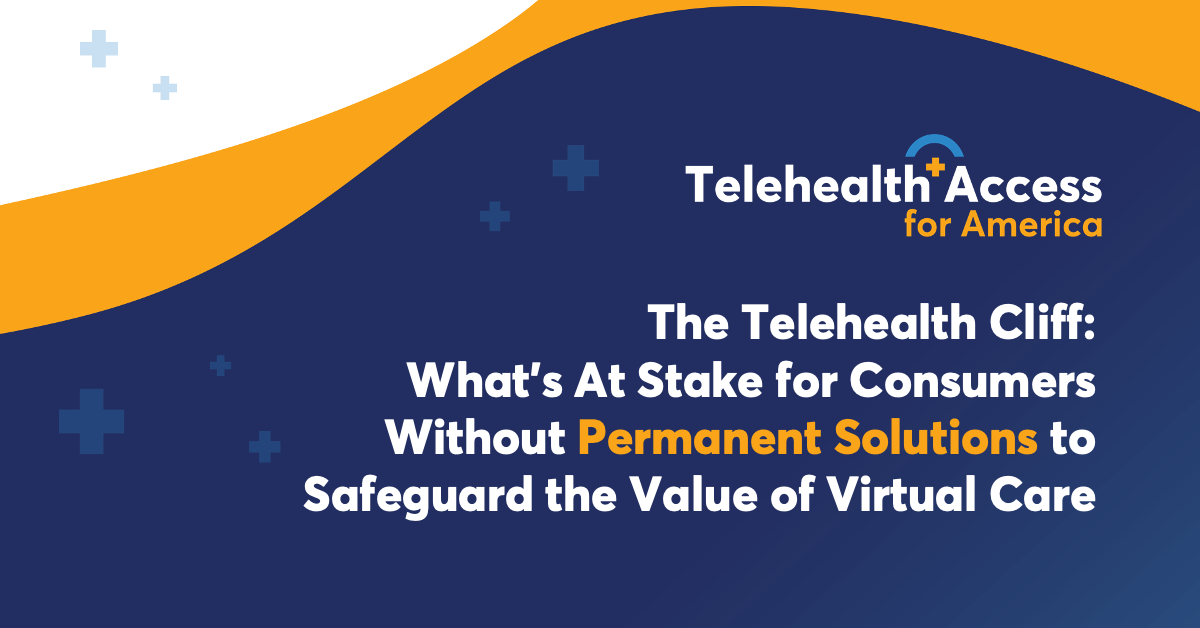What They Are Saying: Health Care Leaders Urge Congress to Permanently Protect Access to Virtual Care Without Onerous Restrictions
TAFA Webinar Features Discussion on Telehealth Cliff, Highlights Value of Virtual Care and Need for Urgent Action
Last Thursday, Telehealth Access for America (TAFA) hosted a webinar, “The Telehealth Cliff: What’s at Stake for Consumers Without Permanent Solutions to Safeguard the Value of Virtual Care.” The event began with opening remarks from U.S. Senator Lisa Murkowski (R-AK) and U.S. Representative Mike Thompson (D-CA-04). Their remarks were followed by expert insights from panelists on the critical value of telehealth for both consumers and providers and a discussion on how the access to virtual care, made possible by flexibilities first issued during the pandemic and extended by Congress in 2022, has become particularly vital for consumers and the future of health care. The panel discussed the urgency for lawmakers to enact permanent protections for access to telehealth without unnecessary restrictions as these flexibilities are set to expire at the end of the year.
Here is some of what speakers and panelists had to say about the value of virtual care and need for action:
U.S. Senator Lisa Murkowski (R-AK): “Improving access to quality, affordable health care has been a priority of mine throughout my time in the Senate, and telehealth services have long been a critical component of the health care system for Alaskans in our most remote communities. All of you know, before the end of the year, millions of Americans who rely on telehealth are liable to lose access to care without a
legislative fix…I’m a co-sponsor of the Connect for Health Act, which would eliminate unnecessary restrictions, such as in-person visits and geographic restrictions… We must ensure that we don’t lose the gains that we’ve made in telehealth access and that we continue to address ongoing barriers to telehealth services such as broadband infrastructure and connectivity.”
U.S. Representative Mike Thompson (D-CA-04): “As we all know, even though telehealth has been around for a while, it was COVID that really brought telemedicine to the forefront. When docs couldn’t run their practices normally and patients were advised to isolate, telehealth just made sense. It saves time, it saves money, and most important, it saves lives…As you all know, we have a deadline coming up in December when current Medicare access to telehealth will expire. I’m continuing to push for as much permanent policy as possible. And fortunately, telehealth is a bright spot for bipartisanship.”
Alisa Vidulich Casavant, Policy Director, Arthritis Foundation: “If you don’t have a care provider that’s within an hour or even multiple hours, we often hear patients have to go out of state in order to find their specialist because they simply don’t exist nearby. Or maybe it takes six or eight hours for them to drive and the closest one might be the next state over. So it really can be, telemedicine is that bridge. It can help bridge the gap and it’s really beneficial for a lot of patients for physical therapy, not even just see their rheumatologist, but it’s the management of their condition throughout their lifetime…Telehealth has and will continue to definitely play an increased role for patients, especially due to time barriers, geographic barriers. It’s often a quick and efficient way for people to access the providers that they need for a quick check-in asking questions in addition to physical therapy or checking in with your 14 care providers.”
Marcelo Ferandez-Vina, JD, MPH Officer, Substance Use Prevention and Treatment Initiative, The Pew Charitable Trusts: “So under the pandemic telehealth flexibilities, we saw that allowing healthcare providers to prescribe buprenorphine remotely helped more patients start and stay in treatment than ever before without increasing overdose deaths. So that’s just a huge change that telehealth has provided, a huge benefit that telehealth has provided people with opioid use disorder. And we also, on the equity front, we saw that the flexibilities helped a wide range of patients. So that includes veterans, people experiencing homelessness, individuals involved in the criminal justice system, people living in rural areas, racial and ethnic minorities…We also saw that allowing buprenorphine to be prescribed via telehealth decreased challenges associated with transportation and geography. And it helped patients with work and childcare responsibilities as well. So telehealth improved access to care for these rural and hard to reach populations, it reduced wait times, and worked around challenges with childcare work, transportation, and stigma.”
Brooke McSwain, Senior National Policy Research Analyst, American Heart Association: “Telestroke is] one of the most well established and longstanding use of telehealth in the CVD space or the cardiovascular disease space. And they provide immediate access to strict specialists and rural and underserved areas…which is a really critical aspect in reducing mortality and morbidity from stroke…Most of the care that we see, that we’ve studied that is provided via telehealth is equal to or better than the care that’s provided in person for most services… From a policy perspective, we want to ensure that we are allowing for the most flexible use of telehealth care as possible because there is no one-size-fits-all, right?… What we want to see is a policy that incentivizes hybrid care… We don’t want to go backwards; we’ve learned some hard lessons from the pandemic, and we don’t want to lose you know the gains we’ve made from that.”
Learn more about Telehealth Access for America (TAFA) and how Congress can act to protect access to telehealth HERE.
ABOUT TELEHEALTH ACCESS FOR AMERICA
Telehealth Access for America (TAFA) is a public education campaign supported by leaders in health care committed to better care, expanded patient choice, and protecting access to critical telehealth services. Learn more and take action today at www.telehealthaccessforamerica.org.

